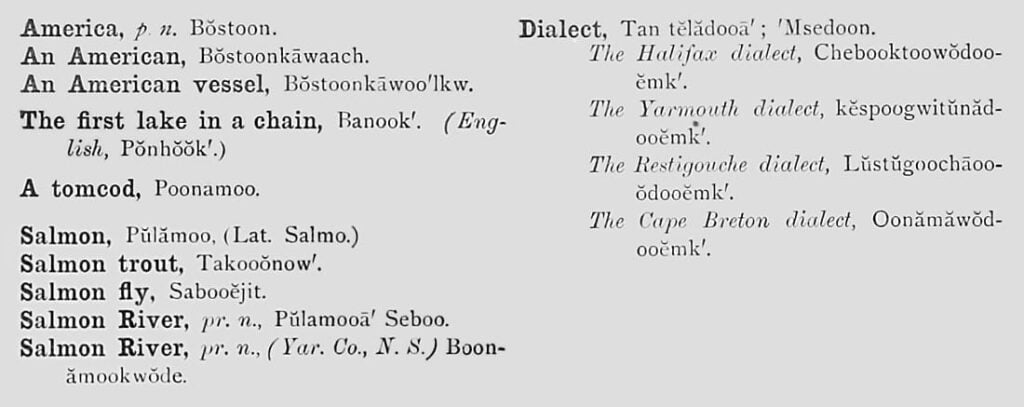“The compiler of the following work has been more than forty years laboring as a Missionary among the [Mi’kmaq]. He considered it a matter of prime importance to make himself acquainted with their language, and early set himself to the task, with what few helps he could command; and his success has surprized himself as well as many others. As many as forty thousand of their words has been collected and arranged in alphabetical order… The compiler of this volume soon discovered, what many are now willing to admit, that the [indigenous] are a very remarkable people, with most remarkable languages, traditions, customs, and habits, and that every thing connected with them is calculated to awaken the deepest interest, for the Christian, the philologist, the ethnologist, and all others who take an interest in exploring the works of nature and of art, and who are interested in the welfare of their fellow men.”
A few interesting tidbits from within:

America, “Bostoon“, An American, “Bostoonkawaach“, An American vessel, “Bostoonkawoo’lkw“, it appears Bostonians served as the archetypal Americans.
The first lake in a chain is noted as “Banook‘”, (English, Ponhook‘), which might explain why “First Lake” was changed to Banook in Dartmouth at some time shortly after the First World War, using dictionaries such as this as a guide.
A Tomcod is listed as “Poonamoo“, included in reference to the assertion Dartmouth was once named “Tomcod ground”, though there was no corresponding listing for “ground” [for linguistic reasons I’m sure, as with place]. Another theory has it that Dartmouth was called “Salmon Place”, backed up by a few early French maps (1, 2) that show a “Salmon jump” in the general vicinity (Saut au Saumon). Salmon is listed and is similar to Tomcod, “Pulamoo“, which might explain why both names are posited but “place” is nowhere to be found as such.
A specific Salmon River, in Yarmouth County, is listed as “Boonamookwode” — which I’m quite sure is a dead ringer for “Ponamogoatitjg“. This is likely the source of Dartmouth’s supposed Mi’kmaq name, yet the generic Salmon River is listed as “Pulammoa’ Seboo” which doesn’t add up. Whether the Yarmouth County name was applied more broadly than just in Yarmouth County, or like Banook, was used later to try and add some “indigenous flair” to Dartmouth after the fact, I’m not sure. Perhaps Dartmouth’s original name was actually Chebucto, once located on the eastern side of the harbor, at least according to a few maps of the place (out of so many at the time, and with such detail that I find it hard to believe it would’ve been depicted on the wrong side of the harbor), which would explain the need to contrive a new name later.
There are at least four dialects listed: The Halifax dialect “Chebooktoowodooemk'”, The Yarmouth dialect “Kespoogwitunadooemk'”, The Restigouche dialect, “Lustugoochaooodooemk'” and the Cape Breton dialect “Oonamawodooemk'”, perhaps representative of broader administrative districts at the time in Mi’kma’ki.
See also:
Rand, Silas Tertius, 1810-1889. Dictionary of the Language of the Micmac Indians: Who Reside In Nova Scotia, New Brunswick, Prince Edward Island, Cape Breton And Newfoundland. Halifax, N.S.: Nova Scotia Printing Co., 1888. https://hdl.handle.net/2027/uc2.ark:/13960/t1vd70h9p

